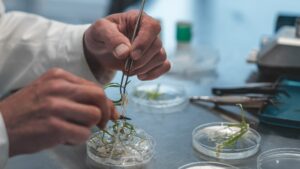The merger of Dow and DuPont, the acquisition of Syngenta by ChemChina, and the merger of Bayer and Monsanto have recently reshaped the global seed industry. Unsurprisingly, this consolidation wave has sparked worries among farmers, policymakers and the broader public, who fear harmful consequences on prices, innovation and product choice. For instance, the European Commission’s Directorate-General for Competition received over a million petitions, e-mails and tweets by citizens expressing their concern about the Bayer-Monsanto merger, an unprecedented level of public attention. However, the public debate around competition and concentration in seed markets was so far hindered by a lack of clear data in the public domain. This made it difficult to know the level of concentration in various markets, its causes, and its consequences.
Check out more recent coverage:
- For the Big 4, the Revolution is Now: https://european-seed.com/2019/03/for-the-big-4-the-revolution-is-now/
- Bayer to Buy Monsanto for $66 Billion: https://european-seed.com/2016/09/bayer-buy-monsanto-66-billion/
- Our Industry is Starting to Look Different. That’s Good for us and the Public, too: https://european-seed.com/2021/11/our-industry-is-starting-to-look-different-thats-good-for-us-and-the-public-too/
- Concentration Everyone: https://european-seed.com/docs/books/volume-4/issue-2/?page=6
A recent study by the Organisation for Economic Co-operation and Development (OECD) sheds some light on these questions. The report, “Concentration in Seed Markets: Potential Effects and Policy Responses”, was published in December 2018 and presents new, detailed evidence on the degree of market concentration in seed and GM technology across a broad range of crops and countries. It analyses the causes and potential effects of increasing concentration, explains how competition authorities in major markets responded to the mergers, and suggests policy options to stimulate competition and innovation in plant breeding. In this article we highlight some of the findings of the study, which is freely available in its entirety online.
From Big Six to Big Four
Consolidation in global seed markets is not a new phenomenon. Over the past three decades, a series of mergers and acquisitions created the “Big Six”: Monsanto, Bayer, BASF, Syngenta, Dow and DuPont. These firms were all active in crop protection chemicals and, with the exception of BASF, also had strong positions in seed and biotechnology. This combination of activities was not a coincidence, but illustrates the complementarities between these activities. Especially after the introduction of herbicide tolerance, it made sense for firms to combine activities in pesticides, seed, and GM technology. Bringing these three technologies in-house made it easier to engage in research and development. The combination also had commercial benefits: selling more herbicide-tolerant seed would stimulate herbicide sales, and herbicide sales in turn would stimulate sales of herbicide-tolerant seed.
The recent merger wave reduces the number of major firms to four (Bayer-Monsanto, DowDuPont/Corteva, ChemChina-Syngenta, BASF). As with previous mergers and acquisitions, the current consolidation combines firms with complementary product portfolios. This is most obvious for ChemChina, which sold pesticides but had no activities in the seed industry before its acquisition of Syngenta, but the same is true of the other mergers. Most of Dow’s agricultural sales came from crop protection chemicals, while most of DuPont’s sales came from seeds and GM traits. The combined firm thus ends up with a relatively balanced portfolio. Bayer was relatively stronger in crop protection chemicals while Monsanto was relatively stronger in seeds and GM traits.
In markets where the mergers would have created a large increase in market concentration, competition authorities required substantial divestitures before allowing the merger. Bayer in particular has been required to divest almost its entire seed business, which was sold to BASF. Prior to the mergers BASF had only limited activities in seed, but it now emerges as an important player – again combining seed and GM technology with crop protection chemicals.
How Concentrated Are Seed Markets?
To highlight the importance of the recent mergers, some observers have claimed that just three companies now sell close to 60% of the world’s seed.[1] These estimates are based on the sales figures of the firms and estimates of the value of the global seed market. However, these statistics are misleading for several reasons. First, estimates of the global seed market can vary considerably by source, and some appear to be too low – which gives the impression of higher market concentration. For instance, many estimates focus only on commercial sales but don’t include farm-saved seed, which is especially important in the developing world. Moreover, because GM seed is more expensive, this approach implicitly overstates the role of firms active in markets where GM seeds are more important – in particular corn and soybean in North and South America. But perhaps most importantly, a global estimate says very little about concentration in a specific seed market: some markets may be more concentrated than the global figure suggests, while others may be less concentrated.

To overcome these problems, the OECD study relies on detailed information from the Kleffmann Group’s amis®AgriGlobe® database. The database uses surveys of farmers and distributors, as well as expert input, to estimate market shares of plant breeders for specific crops in specific countries. Data is available for maize, soybeans, wheat and barley, rapeseed, sunflower, potato, sugar beet, and cotton (although the number of country observations varies by crop). In some cases, estimates from other studies were used as well. These data make it possible to measure and compare market concentration at a fine-grained level – for instance for sunflower seed in Hungary or for maize in France – rather than painting with the broad brush of global aggregates.
To measure how concentrated a market is, the OECD study uses a standard tool of competition analysis known as the Hirschman-Herfindahl Index (HHI). The HHI is defined as the sum of squared market shares of all firms in the market. For instance, if a single firm has a 100% market share, the HHI would reach its maximum value of 10.000. As another example, if four firms each had 25% of the market, the HHI would be 2.500. Markets with an HHI above 2.500 are typically considered “highly concentrated” by competition authorities.
What is remarkable is the variation in concentration levels across markets. The market for cotton seed in Mexico is extremely concentrated: before the mergers, Bayer and Monsanto together held nearly 100% of the market (Bayer has sold its business to BASF). By contrast, market concentration appears to be much lower for some crops such as cereals (which here refers to wheat and barley only) and some countries, especially in Central or Eastern Europe. Interestingly, the data suggests that there are systematic differences between crops. A statistical analysis confirms that seed markets for sugar beet, sunflower and cotton tend to be much more concentrated than seed markets for wheat and barley, for instance. The picture that emerges is one of heterogeneity, with some seed markets more concentrated and others less so – underscoring the importance of using detailed information on specific seed markets rather than broad global aggregates.
How Does Market Concentration Affect Prices And Innovation?
Intuitively, less competition in a market would be expected to lead to higher prices. The data collected in the OECD study makes it possible to test this hypothesis. Using data for 87 seed markets, and correcting for crop-specific and country-specific effects and several other factors, the analysis did not find evidence of higher seed prices in markets with higher levels of market concentration. However, the analysis does suggest that a greater market share for public plant breeders, and a greater share of farm-saved seed, reduce average prices.
Does market concentration lead to lower levels of innovation? To explore this question, the OECD study developed a new measure of innovation in seed markets using data for the European Union. Measuring innovation is usually difficult, and researchers often use imperfect measures such as R&D expenditures or patents. These measures have their shortcomings, because they do not really capture useful new innovations. However, the EU requirement that new seed varieties need to be registered in the National List of a member state allows for a better measure in the case of plant varieties. As registration requires passing a test for the value for cultivation or use (VCU), a new entry on the National List probably represents a valuable innovation. This measure is still not perfect, but probably gives a good approximation of the “true” rate of innovation in the market.
The OECD study analysed data for the number of new entries by crop and by country in the period 2013-2017 and evaluated the link with market concentration as well as crop- and country-specific effects and other factors such as market size. One striking result is that larger markets have more innovation. By contrast, the study did not find any evidence that higher levels of market concentration reduce innovation in EU seed markets.
These analyses have their limitations. For instance, the overall number of observations is quite limited, and the data cannot account for differences in seed quality. Hopefully future research can build on these findings.
Responses By Policymakers
As with other large mergers or acquisitions, the recent transactions in the seed industry were scrutinised by competition authorities. Because of the global scope of the mergers, competition authorities of different jurisdictions (the European Union, the United States, Canada and Brazil, among others) coordinated their work in this area. In addition to traditional concerns about mergers potentially leading to higher prices, the question of innovation was on regulators’ minds as they evaluated the transactions. Before allowing the mergers, firms were required to divest themselves of several businesses to safeguard competition in the industry. For instance, the European Commission required DuPont to sell its crop protection R&D organisation – not only those units in the European Union, but globally. Bayer agreed to sell nearly its entire seed business to BASF, as well as several other businesses.
While most of the discussion on the mergers has focused on decisions by competition authorities, several other policy options exist to stimulate competition and innovation in the seed industry. The OECD study identifies opportunities in three areas. First, although proper regulations are necessary to create trust in markets, excessive regulation could create barriers to entry (which could in turn contribute to higher levels of market concentration) and could slow down innovation in plant breeding. Policy makers should therefore make sure to avoid unnecessary regulatory barriers. This point is of course especially important given the new plant breeding techniques, which could present opportunities to smaller enterprises.
A second important area involves plant breeders’ access to the genetic resources and intellectual property necessary to develop new varieties. Efficient procedures for accessing genetic materials and a regulatory framework which makes it easy to access or license intellectual property can help provide plant breeders with the “inputs” needed for varietal development.
Third, policy makers should stimulate both public and private R&D. Historically, progress in plant breeding has often come from the interplay of public sector and private sector efforts; in many countries, public plant breeders are still an important source of commercially available varieties. As private-sector investment is ramping up, public sector R&D can focus on more fundamental “pre-competitive” research, such as the development of new plant breeding techniques or genome mapping. Policy makers can also stimulate private R&D through public-private partnerships, for instance by providing matching funds.
Given the challenge of feeding a growing population with ever scarcer natural resources, sustainable productivity growth is a top priority for global agriculture. Improved varieties have a major role to play in this regard. For this reason, competitive and innovative seed markets should be high on the agenda of policymakers everywhere.
Read more:
OECD (2018) Concentration in Seed Markets: Potential Effects and Policy Responses, Paris: OECD Publishing. Available online at https://doi.org/10.1787/9789264308367-en
[1] See e.g. Tom Philpott, “Monsanto now belongs to Bayer”, Mother Jones, 13 September 2016. https://www.motherjones.com/environment/2016/09/whoa-monsanto-about-get-swallowed-german-giant-bayer/













